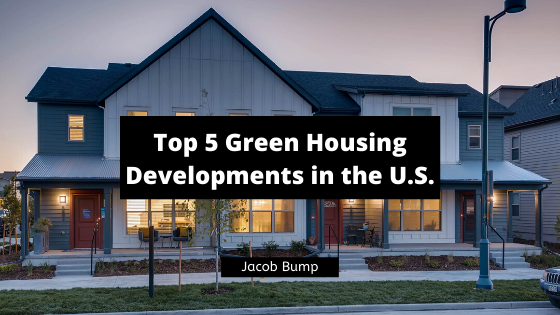The old ways of planning and structuring residential structures in the U.S. seem to be going away.
Green residential development, which takes into consideration a number of environmental and social factors that impact residential communities, is gaining more ground each year.
By 2021, it is expected that 47 percent of construction projects will entail some form of green development.
A big chunk of those projects will be coming from the United States. In fact, many of those projects have already started to surface within the country and made their impact within residential areas across the nation.
The following five U.S.-based green residential developments are outstanding examples of how to build eco-friendly structures that support people, jobs, and the environment without sacrificing luxury and design in the process.
- Mueller: Austin, Texas
This redeveloped area which used to serve as a municipal airport is located just three miles from downtown Austin and two miles from the University of Texas, Austin.
The area was an ideal choice for starting an urban village as it lies right in the center of the city.
The main goals of this redeveloped area were to create new homes and new jobs for those living within Austin and its surrounding area.
Mueller already boasts 14,300 residents, 14,500 employees, and 10,500 construction jobs.
The beautifully redeveloped area includes homes, parks, schools, businesses, restaurants, and retail stores.
As part of the Mueller master plan, which included an extensive green development strategy, the development includes the following features:
- Green Homes (tankless water heaters, solar panels, and programmable thermostats)
- Renewable Water
- Low-Income Housing
- Reusable Airport Hangers (entertainment/info venues)
- Children’s Medical Center
- Ronald McDonald House
Mueller is truly a development made for the people by the people as it is the culmination of many years of planning amongst neighbors, citizens, local developers and the city of Austin.
- Manhattan View at MiMa: Manhattan (Times Square), New York
This luxurious condominium high-rise stands in the middle of Time Square displaying a spectacular view of many of New York City’s famous landmarks for its residents.
The building contains many high-life amenities including:
- Concierge
- Doorman
- Health Club
- Pool
- Central AC
- Washer/Dryer
- Business Center
- Fitness Center
- Full-Service Garage
It also includes some other not-so-common amenities like a basketball court and a pet facility.
Its luxurious surroundings are only matched by its LEED (Leadership in Energy and Environmental Design) Gold Certified features.
Manhattan View at MiMa incorporates an environmental design and strategy that addresses the following eco-friendly issues:
- Energy Savings
- CO2 Emissions Reduction
- Water Efficiency
- Renewable Resources
- Eco-Friendly Indoor Environment
In brief, this residential structure provides the highest luxury living above one of the busiest commercial intersections and tourist destinations in the world while managing to keep a clean and sustainable environment in the process.
- Greenbridge: Chapel Hill, North Carolina
Greenbridge is part of a revitalized neighborhood project that hosts 96-plus residential condominiums.
Although its high-valued condominiums are one of its main attractions, the Greenbridge project is centered more around environmental, ecological, and human health and well-being.
Some of its green residential features include:
- Renewable Building Materials
- Renewable Energy Investments
- Solar Hot Water/Electricity
- Grassroots/Street-Level Retail Shops
- Car-Sharing Programs
- Mass-Transit Access
- Sustainable Education Center
The Greenbridge community has been around for some time. Its redevelopment was established in 2008 and finally completed in 2009.
- Urby: Staton Island, New York
Another New York green development residential project, Urby is unique in its approach to bringing the outdoors to indoor life.
It’s the first New York green residential project that includes an outdoor farm within a residential building!
Aside from its farming capabilities, the Urby neighborhood showcases many other features that are sure to suit those who like the idea of living an urban outdoor life.
Some of Urby’s main amenities, features, and attractions include the following:
- Urban Farm
- Great View (North Shore waterfront)
- Outdoor Lounging (lawns, fire pit, saltwater pool
- Lobby Cafe
- Fitness and Yoga Studio
- Cooking Classes
- Spacious Studio Floor Plans
- Staten Island Ferry Commute
Those who wish to participate in Urby’s residential farm program can also sell their produce at the community farmer’s market on the weekends.
- Stapleton: Denver, Colorado
Stapleton, just ten minutes from downtown Denver, is the country’s largest urban-infill redevelopment project with almost 5,000 acres of reclaimed land.
The idea began after the closing of Stapleton International Airport in 1995. After its closing, citizens, business leaders and civic officials who were concerned not only about the growth of Denver, but also how that growth would impact the people and the environment. They decided to collaborate their efforts, money, and time to redevelop the area using green residential development strategies and principles.
In the end, 7.5 square miles of terminals and runways were shaped into what is known today as Stapleton.
The Stapleton community is just that, a fully functioning community containing housing, schools, parks, stores, restaurants, neighborhood pools, winter festivals, and a community board.
Some of the salient green development features of Stapleton are as follows:
- Rental Apartments
- Affordable Housing
- Energy-Star Certified Homes
- Solar Panel Houses
- Eco-Friendly Land Restoration (Westerly Creek)
- Habitat Restoration
Of particular note are the redeveloped bike paths and bridges which were made from reused concrete taken from the airport’s runways.
It is great to see that many American citizens and businesses are concerned about maintaining the quality of their residential communities and tackling social issues that help better the people as a whole.
The above five green residential development examples give testimony to this fact! If things keep going in this direction, Americans may one day see all future residential developments structure their project planning around green development ideas and philosophies. The result of such efforts would result in a happier, healthier and more holistic nation.
